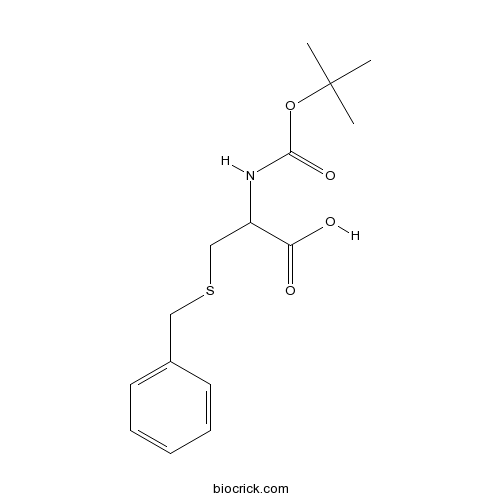Boc-Cys(Bzl)-OHCAS# 5068-28-0 |

Quality Control & MSDS
3D structure
Package In Stock
Number of papers citing our products

| Cas No. | 5068-28-0 | SDF | Download SDF |
| PubChem ID | 294895 | Appearance | Powder |
| Formula | C15H21NO4S | M.Wt | 311.4 |
| Type of Compound | N/A | Storage | Desiccate at -20°C |
| Solubility | Soluble in Chloroform,Dichloromethane,Ethyl Acetate,DMSO,Acetone,etc. | ||
| Chemical Name | 3-benzylsulfanyl-2-[(2-methylpropan-2-yl)oxycarbonylamino]propanoic acid | ||
| SMILES | CC(C)(C)OC(=O)NC(CSCC1=CC=CC=C1)C(=O)O | ||
| Standard InChIKey | IFVORPLRHYROAA-UHFFFAOYSA-N | ||
| Standard InChI | InChI=1S/C15H21NO4S/c1-15(2,3)20-14(19)16-12(13(17)18)10-21-9-11-7-5-4-6-8-11/h4-8,12H,9-10H2,1-3H3,(H,16,19)(H,17,18) | ||
| General tips | For obtaining a higher solubility , please warm the tube at 37 ℃ and shake it in the ultrasonic bath for a while.Stock solution can be stored below -20℃ for several months. We recommend that you prepare and use the solution on the same day. However, if the test schedule requires, the stock solutions can be prepared in advance, and the stock solution must be sealed and stored below -20℃. In general, the stock solution can be kept for several months. Before use, we recommend that you leave the vial at room temperature for at least an hour before opening it. |
||
| About Packaging | 1. The packaging of the product may be reversed during transportation, cause the high purity compounds to adhere to the neck or cap of the vial.Take the vail out of its packaging and shake gently until the compounds fall to the bottom of the vial. 2. For liquid products, please centrifuge at 500xg to gather the liquid to the bottom of the vial. 3. Try to avoid loss or contamination during the experiment. |
||
| Shipping Condition | Packaging according to customer requirements(5mg, 10mg, 20mg and more). Ship via FedEx, DHL, UPS, EMS or other couriers with RT, or blue ice upon request. | ||

Boc-Cys(Bzl)-OH Dilution Calculator

Boc-Cys(Bzl)-OH Molarity Calculator
| 1 mg | 5 mg | 10 mg | 20 mg | 25 mg | |
| 1 mM | 3.2113 mL | 16.0565 mL | 32.113 mL | 64.2261 mL | 80.2826 mL |
| 5 mM | 0.6423 mL | 3.2113 mL | 6.4226 mL | 12.8452 mL | 16.0565 mL |
| 10 mM | 0.3211 mL | 1.6057 mL | 3.2113 mL | 6.4226 mL | 8.0283 mL |
| 50 mM | 0.0642 mL | 0.3211 mL | 0.6423 mL | 1.2845 mL | 1.6057 mL |
| 100 mM | 0.0321 mL | 0.1606 mL | 0.3211 mL | 0.6423 mL | 0.8028 mL |
| * Note: If you are in the process of experiment, it's necessary to make the dilution ratios of the samples. The dilution data above is only for reference. Normally, it's can get a better solubility within lower of Concentrations. | |||||

Calcutta University

University of Minnesota

University of Maryland School of Medicine

University of Illinois at Chicago

The Ohio State University

University of Zurich

Harvard University

Colorado State University

Auburn University

Yale University

Worcester Polytechnic Institute

Washington State University

Stanford University

University of Leipzig

Universidade da Beira Interior

The Institute of Cancer Research

Heidelberg University

University of Amsterdam

University of Auckland

TsingHua University

The University of Michigan

Miami University

DRURY University

Jilin University

Fudan University

Wuhan University

Sun Yat-sen University

Universite de Paris

Deemed University

Auckland University

The University of Tokyo

Korea University
Boc-Cys(Bzl)-OH
- Terfenadine
Catalog No.:BCC3866
CAS No.:50679-08-8
- Chasmanine
Catalog No.:BCN5409
CAS No.:5066-78-4
- Vandrikidine
Catalog No.:BCN5615
CAS No.:50656-92-3
- Alkaloid C
Catalog No.:BCN1897
CAS No.:50656-88-7
- Alkaloid KD1
Catalog No.:BCN1898
CAS No.:50656-87-6
- Niranthin
Catalog No.:BCN5614
CAS No.:50656-77-4
- Octacosanoic Acid
Catalog No.:BCN5395
CAS No.:506-48-9
- Nervonic acid
Catalog No.:BCN8374
CAS No.:506-37-6
- Arachidonic acid
Catalog No.:BCN2215
CAS No.:506-32-1
- Isojacareubin
Catalog No.:BCN6883
CAS No.:50597-93-8
- Columbianadin
Catalog No.:BCN1275
CAS No.:5058-13-9
- Fenspiride HCl
Catalog No.:BCC4659
CAS No.:5053-08-7
- Borneol
Catalog No.:BCN4964
CAS No.:507-70-0
- Pennogenin
Catalog No.:BCN2839
CAS No.:507-89-1
- Vecuronium Bromide
Catalog No.:BCC2498
CAS No.:50700-72-6
- 3-Cyano-6-isopropylchromone
Catalog No.:BCC8627
CAS No.:50743-32-3
- TPCA-1
Catalog No.:BCC2473
CAS No.:507475-17-4
- Polyphyllin D
Catalog No.:BCN2401
CAS No.:50773-41-6
- Polyphyllin B
Catalog No.:BCN2833
CAS No.:50773-42-7
- Soyasapogenol A
Catalog No.:BCN1433
CAS No.:508-01-0
- Oleanolic acid
Catalog No.:BCN5616
CAS No.:508-02-1
- 13(18)-Oleanen-3-ol
Catalog No.:BCN5617
CAS No.:508-04-3
- Glutinone
Catalog No.:BCN5618
CAS No.:508-09-8
- N-acetylanonaine
Catalog No.:BCN2666
CAS No.:5894-74-6
Strong and fast-recovery organic/inorganic hybrid AuNPs-supramolecular gels based on loofah-like 3D networks.[Pubmed:26568047]
Soft Matter. 2016 Jan 21;12(3):957-64.
Super strong and fast-recovery organic/inorganic hybrid gold nanoparticle (AuNPs)-supramolecular gels based on a three-dimensional loofah-like nanoscale network self-assembled by polyhedral oligomeric silsesquioxane (POSS) core supramolecular gelators are reported for the first time. Two series of POSS core organic/inorganic hybrid gelators, POSS-BOC-l-Homophenylalanine (POSS-Hpy) and POSS-Boc-Cys(Bzl)-OH (POSS-Cys), with two types of peripherals having different abilities for driving the self-assembly of AuNPs in gels were designed and synthesized, both of which self-assembled into three-dimensional loofah-like nanoscale gel networks producing hybrid physical gels with fast-recovery behaviors. The mechanical properties of the resultant hybrid gels were dramatically increased by as much as 100 times in the system of sulfur containing POSS-Cys gelators without destroying the fast-recovery behaviors, with the addition of AuNPs, which had direct interaction with AuNPs to give S-Au non-covalent driving force to lead AuNPs self-assemble onto the 3D loofah-like network nanofibres in the supramolecular hybrid gel system. However, in the POSS-Hpy gelator system without sulfur, no strong interaction with AuNPs existed and the POSS-Hpy nanocomposites showed no clear changes in morphology, thermal stability or rheological properties, confirmed by scanning electron microscopy (SEM), transmission electron microscopy (TEM), tube-inversion and rotational rheometer measurements. This indicated that the organic/inorganic hybrid gelator POSS-Cys could be applied to the formation of soft materials in which AuNPs were self-assembled and closely arranged into three-dimensional nanoscale networks. This hybrid material has great potential for applications in self-recovery, nano- and micron-scale electronic devices, because it has both a large mechanical strength and a fast-recovery capability.


